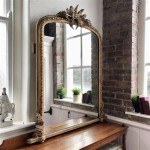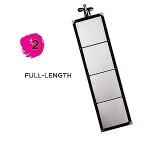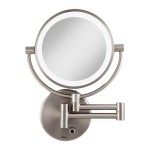Removing a Large Bathroom Mirror Glued to a Wall
Removing a large bathroom mirror that has been glued to a wall can seem like a daunting task. The adhesive used is typically very strong, designed to permanently bond the mirror to the drywall or plaster. An improper removal technique can result in damage to the wall, the mirror itself, or potentially injure the person performing the removal. This article provides a detailed, step-by-step guide to safely and effectively removing a glued-on bathroom mirror, minimizing the risk of damage and injury. Understanding the challenges and employing the correct tools and techniques is crucial for a successful outcome.
The primary concern when dealing with glued-on mirrors is the potential for shattering the mirror during the removal process. Tempered glass, commonly used in bathroom mirrors, will shatter into small, relatively harmless pieces when broken. However, if the mirror is not tempered, it can break into large, sharp shards, posing a significant safety hazard. Furthermore, even with tempered glass, the small pieces can be difficult and time-consuming to clean up. Protecting oneself with appropriate safety gear and taking precautions to contain any potential breakage is paramount.
Before starting the removal process, it is essential to gather the necessary tools and materials. These include safety glasses, heavy-duty gloves, a long-sleeved shirt, and sturdy footwear to protect against glass shards. Other essential items include a utility knife, a piano wire or flexible saw blade (such as a reciprocating saw blade without the saw), a putty knife or scraper, a heat gun or hair dryer, painter's tape, shims (plastic or wood), a hammer (optional), a drop cloth or plastic sheeting, and a trash container for disposal of the mirror and debris. The preparation phase is critical for a smooth and safe removal.
Key Point 1: Preparation and Safety Measures
The first step in removing a large, glued-on bathroom mirror is thorough preparation. Begin by covering the floor and surrounding surfaces with a drop cloth or plastic sheeting. This will protect the flooring from scratches and make cleanup much easier. Carefully tape the mirror's surface with painter's tape, creating a grid pattern. This grid will help hold the mirror together and minimize shattering if it breaks during removal. Overlap the tape strips significantly for maximum effectiveness.
Next, inspect the perimeter of the mirror where it meets the wall. Look for any caulk or sealant that needs to be removed. Use a utility knife to carefully score along the edges of the mirror, cutting through the caulk or sealant. This will create a clean separation between the mirror and the wall, facilitating the insertion of tools later in the process. Repeat this process around the entire perimeter of the mirror.
Safety is of utmost importance. Wear safety glasses, heavy-duty gloves, a long-sleeved shirt, and sturdy footwear throughout the entire removal process. This protective gear will shield you from potential glass shards and sharp edges. Consider wearing a dust mask as well, especially if the adhesive used is old and brittle, as it may release dust particles when disturbed.
Ventilation is another crucial consideration. If possible, open a window or turn on a bathroom exhaust fan to improve air circulation. This will help dissipate any fumes released by the adhesive when heated. A well-ventilated workspace promotes a safer and more comfortable working environment.
Key Point 2: Separating the Mirror from the Wall
Once the preparation is complete, the next step is to separate the mirror from the wall. There are several methods that can be used, depending on the type and strength of the adhesive used, as well as the composition of the wall. One common technique involves using a piano wire or flexible saw blade to cut through the adhesive.
Carefully insert the piano wire or saw blade between the mirror and the wall, starting at one corner. Use a gentle sawing motion to cut through the adhesive. Work slowly and patiently, maintaining a steady pressure. Avoid forcing the wire or blade, as this could crack the mirror or damage the wall. Continue sawing around the perimeter of the mirror, working your way inward. This process may take some time, especially if the adhesive is particularly strong.
Another effective method involves using a heat gun or hair dryer to soften the adhesive. Direct the heat at the back of the mirror, focusing on the areas where the adhesive is located. The heat will help to weaken the bond between the mirror and the wall, making it easier to separate. Be careful not to overheat the mirror, as excessive heat can cause it to crack. Periodically test the mirror's adherence by gently prying at the edges with a putty knife or scraper.
As the adhesive softens, insert shims between the mirror and the wall to maintain the separation. This will prevent the mirror from re-adhering and make it easier to continue the removal process. Start with small shims and gradually increase their size as the mirror becomes more separated. Work slowly and carefully, ensuring that the mirror remains stable and supported.
A putty knife or scraper can also be used to gently pry the mirror away from the wall. Insert the putty knife between the mirror and the wall and gently apply pressure. Avoid using excessive force, as this could damage the wall or shatter the mirror. Work slowly and carefully, gradually increasing the pressure until the mirror begins to separate. Continue working around the perimeter of the mirror, prying it away from the wall until it is completely detached.
Key Point 3: Final Removal and Cleanup
Once the mirror is completely separated from the wall, the final step is to carefully remove it and clean up the area. Have a helper assist you in lifting and carrying the mirror, especially if it is large and heavy. Lift the mirror straight off the wall and carefully set it down on a protected surface, such as a drop cloth or plastic sheeting. Avoid tilting or twisting the mirror, as this could cause it to crack or break.
With the mirror removed, the wall will likely have residual adhesive. There are several methods of removing this adhesive. Applying heat from a heat gun or hair dryer can soften the adhesive, making it easier to scrape off with a putty knife or scraper. Be careful not to damage the wall surface during this process.
Chemical adhesive removers are also available at hardware stores. Always follow the manufacturer's instructions carefully when using these products, and ensure adequate ventilation. Test the remover in an inconspicuous area first to ensure it does not damage the wall paint or finish.
After removing the adhesive, thoroughly clean the wall with a damp cloth and mild detergent. This will remove any remaining residue and prepare the wall for patching and painting, if necessary. Inspect the wall for any damage, such as holes or cracks, and repair them as needed. Use drywall patch or spackle to fill in any imperfections and sand the surface smooth.
Dispose of the mirror and all debris properly. Wrap the mirror in a protective material, such as bubble wrap or cardboard, to prevent it from breaking during handling. Contact your local waste management authority for information on how to dispose of large glass items safely and legally. Clean up the work area thoroughly, sweeping up any glass shards or debris. Use a vacuum cleaner to remove any small particles that may have been missed. Finally, dispose of the drop cloth or plastic sheeting in a trash bag.
In conclusion, removing a large bathroom mirror glued to a wall requires careful preparation, the right tools, and a methodical approach. By following these steps, one can minimize the risk of damage and injury and successfully remove the mirror without incident. Prioritizing safety and taking the time to work slowly and carefully will ensure a positive outcome.

How To Safely And Easily Remove A Large Bathroom Builder Mirror From The Wall Site Title

How To Remove A Large Mirror That S Glued The Wall Emerging Home

How To Remove A Bathroom Mirror Lowe S

How To Safely And Easily Remove A Large Bathroom Builder Mirror From The Wall Site Title

How To Remove A Mirror Glued The Wall Forbes Home

How To Safely And Easily Remove A Large Bathroom Builder Mirror From The Wall Site Title

Removing A Glued On Mirror From Wall

How To Safely And Easily Remove A Large Bathroom Builder Mirror From The Wall Site Title

How To Remove A Frameless Mirror Like Nervous Grandma

Large Mirror Removal Safely








